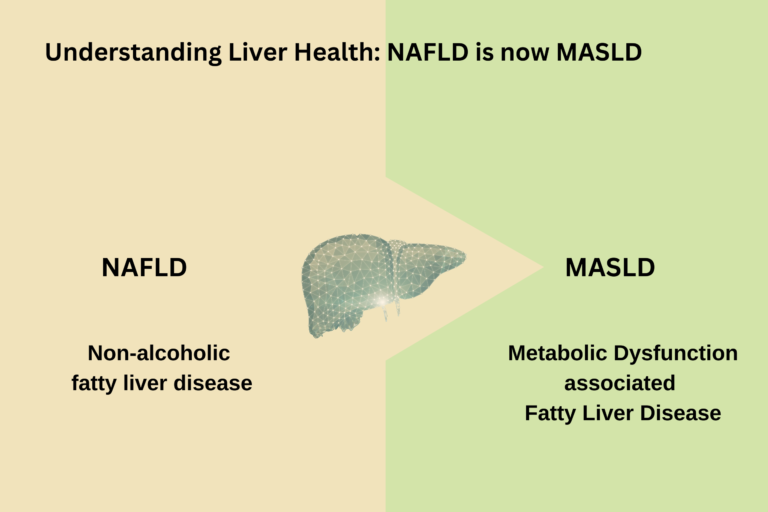
The field of hepatology is witnessing significant advancements, not just in the treatment and diagnosis of liver diseases but also in the terminology used to describe these conditions. One of the most notable changes in recent times is the reclassification of non-alcoholic fatty liver disease (NAFLD) as metabolic dysfunction-associated fatty liver disease (MASLD). This shift in nomenclature reflects a deeper understanding of the disease’s metabolic underpinnings and aims to improve diagnostic criteria and treatment approaches.
Understanding the Change: From NAFLD to MASLD
NAFLD has long been the term used to describe a spectrum of liver conditions characterised by the accumulation of fat in the liver of people who consume little or no alcohol. However, this terminology has limitations, primarily because it describes the disease by what it is not (i.e., unrelated to alcohol) rather than what it is, which has led to some ambiguity in diagnosis and understanding.
MASLD—Metabolic Dysfunction-Associated Fatty Liver Disease—is the new term that more accurately encapsulates the primary driver of the condition: metabolic dysfunction, including factors such as insulin resistance, obesity, type 2 diabetes, and dyslipidemia. By focusing on the metabolic aspects, the new terminology aligns better with the disease’s underlying causes and helps create a more targeted approach to diagnosis and treatment.
Why the Change Matters
Improved Diagnostic Criteria: MASLD provides a framework for diagnosis by emphasising metabolic dysfunction as a core component. This change encourages healthcare providers to look beyond liver-specific symptoms and consider broader metabolic indicators, leading to more comprehensive patient evaluations.
Enhanced Patient Understanding: MASLD is more descriptive and informative for patients. It helps them understand the connection between metabolic health and liver disease, promoting better patient education and engagement in their care.
Targeted Treatment Approaches: Recognizing metabolic dysfunction as a central element of MASLD allows for more precise treatment strategies to address the specific metabolic issues contributing to liver disease, potentially improving outcomes.
Research and Development: The reclassification to MASLD paves the way for more focused research efforts. Scientists can now concentrate on the metabolic pathways involved in the disease, which could lead to the discovery of new therapeutic targets and interventions.
Clinical Implications of MASLD
The shift to MASLD is not merely a semantic change; it has substantial clinical implications. Clinicians and healthcare practitioners are increasingly looking at a holistic approach to treating fatty liver disease patients:
Comprehensive Metabolic Screening: This involves assessing patients for metabolic syndrome components, including blood glucose levels, lipid profiles, and body mass index (BMI).
Lifestyle Modifications: To manage MASLD, people are advised to emphasize a healthy diet, exercise, and weight management. Vegetables, fruits, lean proteins, and whole grains are considered advisable.
Pharmacotherapy: Exploring medications that address insulin resistance, hyperlipidemia, and other metabolic abnormalities. Medications like GLP-1 receptor agonists and SGLT-2 inhibitors, used in diabetes management, are being investigated for their potential benefits in MASLD.
Conclusion
The reclassification of NAFLD to MASLD marks a significant milestone in the field of hepatology as it tracks the root cause and addresses the metabolic roots of fatty liver disease. This new nomenclature enhances diagnostic precision and patient comprehension and opens new research and treatment avenues. As our understanding of liver diseases continues to evolve, such updates in terminology and classification will be crucial in improving patient care and outcomes.
For more insights and updates on liver health, follow Liverindia.in and stay informed with the latest advancements in hepatology.
References:
“Non-Alcoholic Fatty Liver Disease (NAFLD) renamed to Metabolic Dysfunction-Associated Fatty Liver Disease (MASLD).” ScienceDaily.
“Advances in Liver Disease Nomenclature: From NAFLD to MASLD.” Liver Health Research.
“Understanding the Metabolic Underpinnings of MASLD.” Journal of Hepatology.
This review aims to brief the evolving nomenclature in liver health and its implications for diagnosis and treatment. Stay tuned for insights about Liver Health from Liverindia.in.

